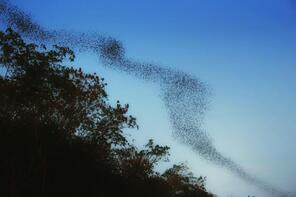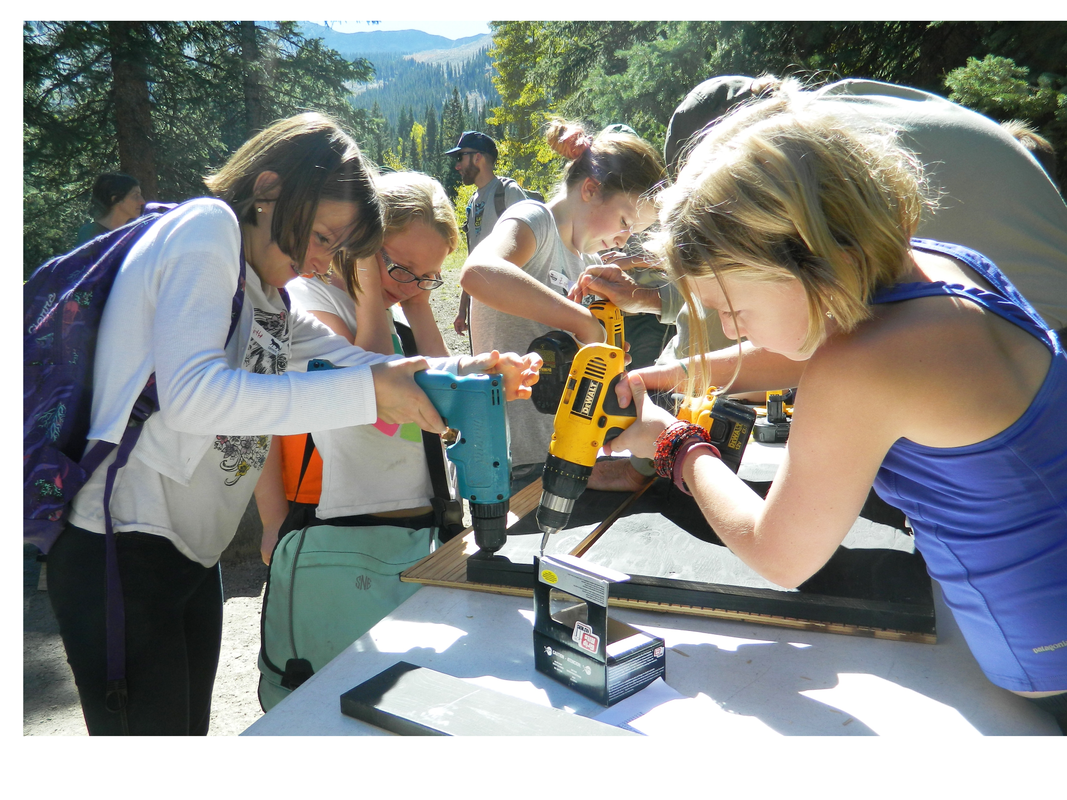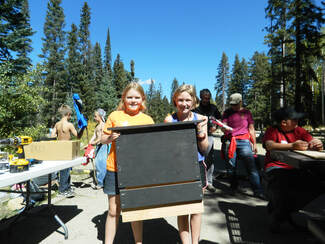|
Tips to help you connect your family to nature!
|
|
The summer evening bat exodus from the Orient Land Mine (San Luis Valley) which hosts the largest colony of Mexican Free-Tailed Bats in Colorado. Bats eat millions of insects every night intercepting migrant pests before they can lay eggs, saving huge amounts of money for farmers. (Credit: Umkehrer (istock) That is, if you happen to be an insect! These night stalkers have been known to eat upwards of 1,200 insects per hour, and that includes mosquitoes. These warm blooded, nocturnal creatures are often associated with the spookiest of holidays. Any guesses as to the animal in question? Why, bats, of course!
So how did bats become the creepy representatives of Halloween? Let’s start with a couple of myths: Bats drink blood, right? Well, not exactly. There are only three species of bat that feed primarily on blood (the “vampire” bats), while the remaining ~1,400 species feed on things like insects, rodents, and nectar. Vampire bats are where the group as a whole got their connection to Halloween. When these bats were first observed lapping up the blood of cattle in Central and South America they were quickly given the label of “vampires.” This idea was made concrete when Bram Stoker’s Dracula (1897) depicted vampires’ shapeshifting into bats. Additionally, rumors have it that witches used bat blood in their “flying” concoctions. It’s no wonder bats have gotten a bad rap! Here are a few more myths regarding bats:
Who needs pesticides when we have bats? The natural pest-control services provided by insect-eating bats in the United States likely saves farmers at least $3 billion a year, and yet insectivorous bats are among the most overlooked economically important, non-domesticated animals in North America, according to an analysis in the journal Science. From deserts to rainforests, nectar-feeding bats that drink the sweet nectar inside flowers pick up a dusting of pollen and move it along to other flowers as they feed. Bat pollination is critical for a wide variety of plants such as giant cacti, agave and many commercial plant products. Bats often cover vast distances each night. When they happen to cross clearings and defecate in flight, bats can scatter seeds of native plants, helping to naturally re-vegetate disturbed landscapes. With more than 1,400 species, bats are the second largest order of mammals. In Colorado, we have 18 bat species that can be found in every habitat—from the eastern plains to the high mountain forests and western deserts, from rural Colorado to downtown Denver. Some are here year-round, and some only migrate through the state. The bats you are most likely to see here on the Western Slope of Colorado are the Big Brown Bat (year- round residents hibernating in places like mines, caves, fissures and other places in winter), the Silver-Haired Bat (migratory – they fly south in winter) and Townsend’s Big-Eared Bat (year-round residents hibernating in winter). Guides will help you positively identify bats. One from Colorado Parks & Wildlife (CPW) is called “Bats of the Rocky Mountain West.” CPW monitors bat populations as part of a nationwide effort to detect changes from threats including White-Nose Syndrome and wind energy development. To learn more, visit: https://cpw.state.co.us/learn/Pages/Bats.aspx This time of year, the only bats you are likely to see are the child- sized, black bats slinking around your neighborhood on October 31st. However, in spring and summer, there are many places where you can observe bats. Bats seek out a variety of daytime retreats such as caves, rock crevices, old buildings, bridges, mines, and trees. During the evening, they are on the hunt for insects near light sources and along creeks and drainages. On the western slope of the Sangre de Cristo Mountains in the San Luis Valley, the Orient Mine hosts the largest colony of Mexican Free-Tailed Bats in Colorado. As the sun sets each summer evening, black clouds billow from the mouth of the abandoned iron mine when it’s time to hunt. There are extraordinarily large numbers—100,000 male bats on average—from June to early July in the mine. By the end of October, the colony’s population will swell as high as 250,000 as the ladies and their pups meet up with the guys in preparation for winter migration. Since bats are surprisingly helpful creatures, what can you do to help the bats in your neck of the woods? This a perfect time to get some great ideas! National Bat Week is celebrated each year during the last week of October, this year from October 24-31, 2021. Visit www.batweek.org to learn more about these critters and discover ways to help improve the environment for bats. BatsLIVE – is an online, distance learning adventure and a one-stop resource for learning about bats with lesson plans, recorded webcasts, and multimedia tools all focused on bats. Do you want to know more about the disease devastating our bat populations? Watch the film “Battle for the Bats” to learn more about White-Nose Syndrome (WNS) and the important role that the public can play in bat conservation. This Halloween, while you are looking forward to those sweet treats, consider “treating” the bats in your neighborhood with a place to roost. Building a bat house is a fun family project. The National Wildlife Federation website (https://www.nwf.org/garden-for-wildlife/cover/build-a-bat-house) provides easy instructions and information on the best placement location to meet the needs of these voracious mosquito eaters. Bats have a bad rap, but the more you know, the more fascinating these little critters get. Now that we’ve cleared up some of those Halloween myths, let’s “Go to Bat for Bats!” and keep them coming back to our neighborhoods.
0 Comments
Leave a Reply. |
Blogs for Summer! DIY Summer Camps A Summer backyard Bucket List Hiking with Children 101 Kids, Dogs and Hikes a Winning Combination Getting Outdoors is Easier than You Think Categories
All
Archive
Archives
July 2024
|





 RSS Feed
RSS Feed


